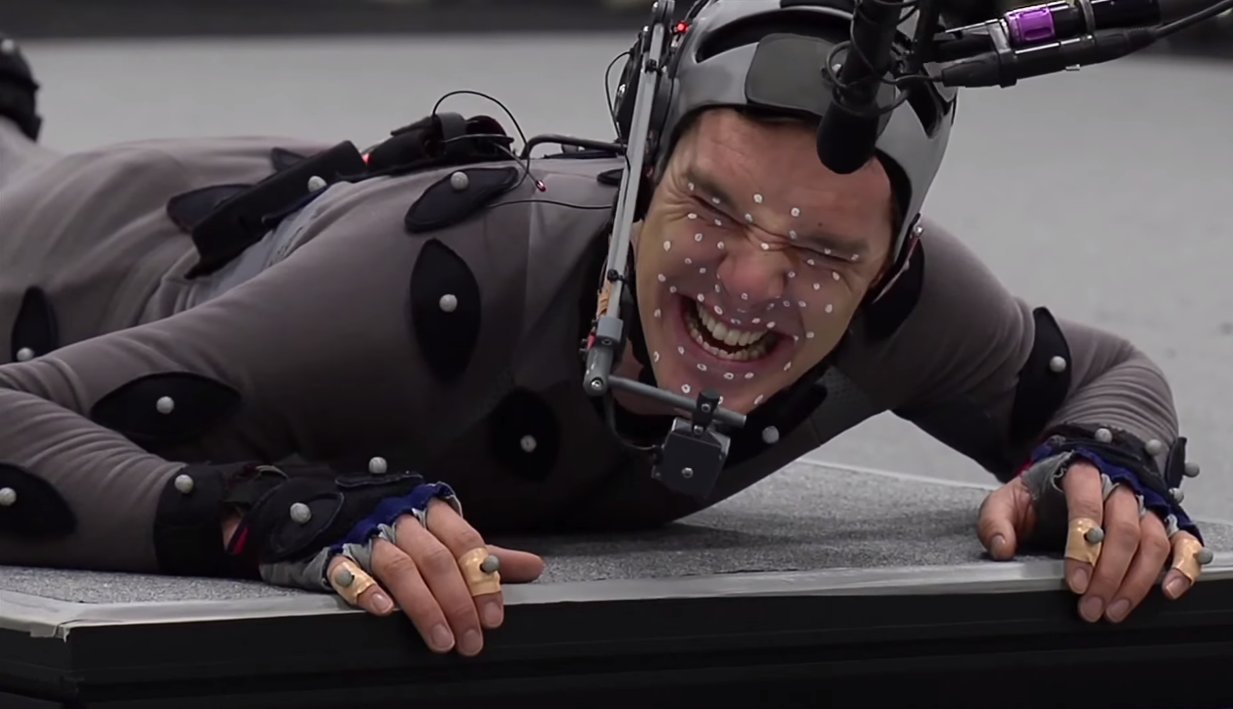

Courtesy MGM
A delightful clip of Benedict Cumberbatch playing Smaug for The Hobbit: The Desolation of Smaug made the rounds last week, showcasing the weirdness of motion-capture performance. In the video, he wears a full body suit, and white dots are speckled on his face. Yet as funny as this sight is, most people probably weren’t surprised by it. After all, we’ve seen Hollywood actors decked out in ball-studded jumpsuits for motion capture roles throughout the past decade.
For The Hobbit, Cumberbatch is playing a flying, six-limbed reptile. But in reality he has cheeks, a mouth, and eyes on the front of his face — no wings to speak of. Crossing that boundary is a strange feat for the actor, but it’s even more demanding for the animators.
“I haven’t yet met an actor who doesn’t want to do it.”
USC graphics researcher Paul Debevek discussed cross-species motion capture with Popular Science. Debevek spent time at Wetta Digital when the company worked on graphics for the latest Hobbit movie, and he also lent his talents to CGI-heavy films like King Kong, Avatar, and this past summer’s Malificent. “There’s a real creative challenge to figuring out how a creature’s face should relate to a human face,” he says.
Those white dots on Cumberbatch’s famous mug help the computer track his expression–but that person-shaped constellation of markers doesn’t fit easily onto a dragon. (Fun fact: even though Cumberbatch is light-skinned, white dots contrast more with his tone in absolute terms than black dots would, making them the ideal choice.)
Most famous examples of motion capture to date involve human-like characters. Andy Serkis, the human behind Gollum, King Kong, and Caesar the ape is perhaps the performer most well-known for motion capture technology roles. He has developed a reputation as a master of the form bringing all those nonhuman (but definitely bipedal) beings to life on screen. In the first _Lord of the Rings _film, he simply stood in for Gollum on set, and animators used software to paint the decayed Hobbit over his body, mimicking his actions. By for the second and third films, Serkis wore a suit much like Cumberbatch’s. Reflective beacons at key points on the fabric bounced light at the cameras, allowing animators to match Serkis’s motions to key points on a digital model of Tolkein’s monster.
The advent of advanced face-acting motion capture has driven more mainstream stars like Cumberbatch into the game. James Cameron’s 2009 blockbuster Avatar saw Sigourney Weaver, Zoe Saldana, and Sam Worthington transformed into the giant blue Na’vi aliens–acting with head-mounted cameras like the one Cumberbatch wears recording their every grin and scowl. But the Na’vi, though an alien species, had the convenient builds of lanky bipedal acrobats and faces that closely resembled their performers. Translating human expressions for the nearly $500 million film was a comparatively simple task. (Ingredients: one celebrity, two silly ears.)
The task of plastering human expressions across a non-human face involved a lot more decision-making after the performance itself was recorded. Debevek says the most important ingredient in Smaug was animators’ creativity. Teams of artists and technicians had to decide how to extrapolate dragon-y motion from Cumberbatch’s human-y grimaces. Debevek says he once witnessed visual effects supervisor Joe Letteri and his two top animators meet for half an hour to discuss whether Smaug’s lips should “curl up or down a little bit” when the actor sneered.
In the clip, Cumberbatch is prone presumably to best imitate a quadraped. But his knees don’t even bend in the right way, and without wings those motions had to match his body through pure imagination.
Despite these challenges Debevek says he believes more Hollywood stars will don bodysuits and head-mounted cameras for fantasy roles. “I haven’t yet met an actor who doesn’t want to do it,” he says. “The performance capture process offers creative opportunities that would never otherwise be available.”
In other words: who wouldn’t want to play a dragon?
